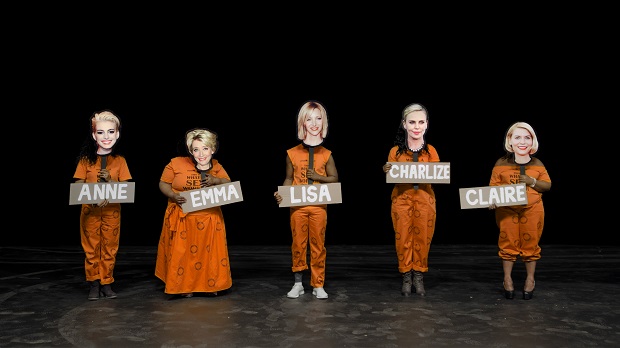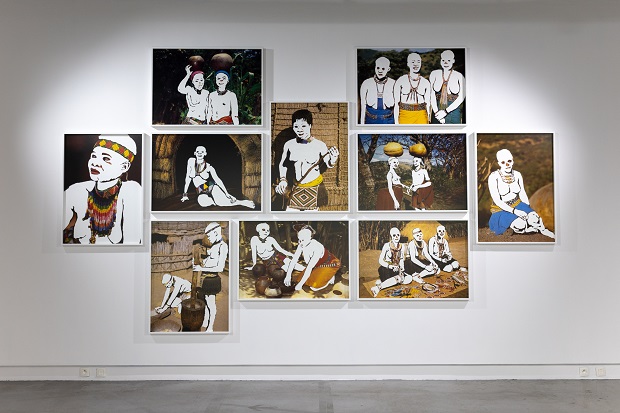- Daily & Weekly newsletters
- Buy & download The Bulletin
- Comment on our articles
South African artist Candice Breitz questions white privilege in solo show ‘Off Voices’ at Charleroi
Internationally-renowned contemporary artist Candice Breitz was initially nervous about filling the cavernous expanse of Charleroi’s post-industrial art museum BPS22 with her first Belgian solo show Off Voices.
“It was definitely one of the more nerve-wracking opportunities because it is a challenging space,” admits the Berlin-based South African artist, known for her moving image installations. It was also “a privilege to work with such a generous team” at the Hainaut province institution, a beacon for contemporary, radical and accessible art.
“Privilege” is a pertinent word for Breitz, as she grew up in the apartheid era and has created a body of work over the past 30 years that questions racial and gender discrimination. She also explores identity and an individual’s relationship with their greater community.
“What makes you, you and what makes me, me? Is it the fact that my father is Jewish, that I was born in South Africa, that I’m white and that I’m an English speaker? I’m interested in how these ingredients get cooked together into an identity,” she explains.
Breitz interrogates white privilege through the prism of the influence of mainstream media. The title of the show, curated by BPSS’s Dorothée Duvivier, refers to the main tenet of her work: giving a voice to people who are usually silenced.

Among the six works on display, one of the most emotionally powerful is TLDR 2017. It arose from a true story about an ideological battle between feminists, Amnesty International and an unlikely coalition of Hollywood actresses and sex work abolitionists, which was sparked by the assassination of a young sex worker by an artist in Cape Town in 2013.
In a darkened room, a 60 minute musical version of the affair is screened that features a glorious Greek chorus composed of 11 sex workers from the (SWEAT) taskforce. Protest songs, mainly in Xhosa and Zulu, along with chants of “Decrim’ punctuate the rowdy dance party that makes for compelling viewing.
The title of the work is a social media acronym ‘Too Long, Didn’t Read’, suggesting that the female celebrities who signed a viral petition rejecting Amnesty’s detailed proposal to decriminalise sex work, probably did not read the full proposal. Individual video testimonies with the group reveal the tough work conditions. On display are their protest placards and bright orange outfits that resemble prison uniforms and bear the logo ‘This is What a Sex Worker Looks Like’.
The enlightening project was the result of an 18-month collaboration between Breitz and SWEAT that proved to be a transformative experience for the artist. She acknowledges that her previous understanding of feminist attitudes to sex work was theoretical. “It’s completely different to be educated by a community of people who are living these lives.”
Breitz discovered a generation divide between the workers. “The evil genius of the apartheid government was to ensure that black South Africans remained barely educated, so older women have less access to complex discourse and the younger ones are knife shape who understand their work politically.”
The 40% unemployment level in South Africa means that these women “would not choose to do sex work if they had better paths through life”.

Having burned all of her earlier work, Breitz’s first artistic endeavour was Ghost Series 1994-96. Created shortly after leaving Johannesburg at the age of 22 and after the official end of apartheid in 1994, the eerie images attest to the fact that the regime is “alive and well”.
A collection of enlarged tourist postcards of black women – staged for idealised white fantasies of Africa – have had their bodies whitened with corrector fluid. The series provoked sharp criticism for their apparent racist prejudice. Some of these critics’ texts are displayed along with Breitz’s own present-day reflection on her work as “the sincere yet unsophisticated attempt of a very young artist to consider the weight of her own privilege as a white South African”.
By continuing to show the series, the artist highlights identity and how perspectives are formed. The application of white fluid to the photographs makes these areas appear as cut-outs, reflecting the surrounding white walls of the institutions and galleries that usually hang the series. It’s a pertinent nod to the ongoing discourse on colonialism in countries such as South Africa and Belgium.

When Breitz was invited to represent South Africa at the 2017 Venice Biennale, she deflected the honour by inviting 10 notable artists from her country to feature in the film portrait series Profile. Together, they disrupt the narrative by placing the notion of identity firmly centre stage. The disparate group asks who can truly represent a country like South Africa where only 8% of the population is white.
The installation Digest – a series of neat shelves of row after row of tombstone-like black painted video tapes – initially appears obscure. Looking closer, each tape bears a different single word. The project decrying patriarchal violence started during lockdown, explains Breitz. It was inspired by Scheherezade and the legend of One Thousand and One Nights that the artist interprets as an act of storytelling proving to be a life-saving feminist weapon.

Each of the 1001 tapes contains a hidden video film, spanning a century of cinema, and ranging from Die Hard to Harry Potter. The action verb hand painted on each one is extracted from the film’s title and written in the same typography as the film. They express an activity and are grouped according to theme so that each section can be read out as a poem.
The final video is placed in isolation on a pedestal. Entitled Labour, it is a tribute to Charleroi’s industrial past and links to the next installation. To experience the film series Labour, visitors are invited to duck inside six curtained semi-circular viewing cabins to view the experience of women giving birth. Breitz reverses the process so that newborns are filmed being removed from their mothers’ arms and breast while slowly being sucked back into the womb.

An accompanying ‘Matricial Decree’ transforms the installation into a “disturbingly dystopian” work that is simultaneously “earnestly utopian”. According to an explanatory text, the decree has been issued by the ‘Secular Council of the Utopian Matriarchat’, known as S.C.U.M. that exercises a zero tolerance policy to those who harm the bodily autonomy of women.
This explains the titles of the individual videos, such as LABOUR (PMURT) that was filmed days before Donald Trum’s first inauguration as US president in 2017. Others bear the titles (OANOSLOB), (KIM), (PUTIN), etc. Each of the leaders alluded to are confronted with the ultimate punishment of being withdrawn from the world by women who selflessly use their wombs to retract those guilty of patriarchal crimes.
The final installation Babel Series (1999) was Breitz’s first video work. Seven monitors blast out extracts from music videos by famous pop stars from the 80s and 90s, such as Madonna, Geroge Michael and Freddie Mercury. The stuttering, monosyllabic fragments repeat one word from the biblical stories evoked in the songs titles. This results in a cacophonous sound that transforms the iconic works into childish babble; an allusion to the manner in which the entertainment industry reduces fans to an infantile state.
Each of these installations is the result of detailed research with a clear ethos questioning society and its political systems. Breitz is an engaging, profound and generous artist, whose body of work is made up of layers of meaning, which can be peeled away for an engrossing viewer experience.
Candice Breitz. Off Voices
Until 11 May
BPS22
Boulevard Solvay 22
Campus Charleroi Metropôle
Charleroi
Photos: Candice Breitz TLDR courtesy Goodman Gallery London; Ghost Series, courtesy Studio Breitz ©Leslie Artamonow; Profile extrait Gerald Machona 2017 ©KOW Berlin; I know you think I'm crazy but I'm not I'm not, extrait de Digest Archive ©KOW Berlin/Saverio Cantoni; Labour, coprod Neuer Berliner Kunstverein, courtesy Goodman Gallery London and KOW Berlin ©Leslie Artamonow


















